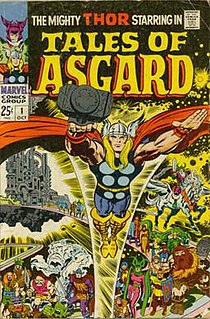
Asgard is a fictional realm and its capital city appearing in American comic books published by Marvel Comics. Based on the realm of the same name from Norse mythology, Asgard is home to the Asgardians and other beings adapted from Norse mythology. Asgard first appeared in Journey into Mystery #85 by Stan Lee, Larry Lieber and Jack Kirby, and features prominently in stories that follow the Marvel Comics superhero Thor, who appeared two issues earlier.

Balder the Brave is a fictional character appearing in American comic books published by Marvel Comics. The character is based on the deity Baldr from Norse mythology.

Odin is a fictional character appearing in American comic books published by Marvel Comics. The character is first mentioned in Journey into Mystery #85, then first appears in Journey into Mystery #86, and was adapted from the Odin of Norse mythology by Stan Lee and Jack Kirby. The character is depicted as the father of Thor and former king of Asgard.

The Executioner is the name of different fictional characters appearing in American comic books published by Marvel Comics.
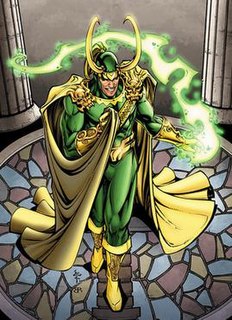
Loki is a fictional character appearing in American comic books published by Marvel Comics. Created by writer Stan Lee, scripter Larry Lieber and penciller Jack Kirby, a version of the character first appeared in Venus #6. The modern-day incarnation of Loki first appeared in Journey into Mystery #85. The character, which is based on the Norse deity of the same name, is the Asgardian "God of Mischief", the adopted son of Odin and the brother of the superhero Thor. Loki has been portrayed as both a supervillain and antihero. The character is most often strictly depicted as a male, but has on occasion been depicted as genderfluid.

Enchantress is the common primary alias of two fictional characters appearing in American comic books published by Marvel Comics. The first of these is a powerful sorceress with the real name of Amora; she is one of Thor's greatest enemies. The second Enchantress is the young Sylvie Lushton, who was given great mystic powers by Loki when he created her as a tool for chaos. She models herself after the original Enchantress, Amora.
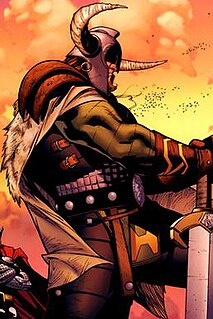
Heimdall is a fictional character appearing in American comic books published by Marvel Comics. The character is based on the Norse deity Heimdallr. Heimdall is described as all-seeing and all-hearing and is the sole protector of the Bifröst in Asgard.

Volstagg is a fictional character appearing in American comic books published by Marvel Comics. He is a charter member of the Warriors Three, a trio of Asgardian adventurers and supporting cast of Thor. He is known for having multiple children. These include, but are not limited to, Hilde, Rolfe, and the adopted Midgardians Kevin and Mick.

Fandral the Dashing is a fictional character appearing in American comic books published by Marvel Comics. He is a charter member of the Warriors Three, a trio of Asgardian adventurers consisting of Fandral, Hogun the Grim, and Volstagg the Valiant. They are members of the supporting cast in Marvel's Thor comics and usually provide comic relief and side-adventures.

Hogun the Grim is a fictional character appearing in American comic books published by Marvel Comics. He is a charter member of the Warriors Three, a trio of Asgardian adventurers and supporting cast of Thor in the Marvel Universe.

Sif is a fictional character appearing in American comic books published by Marvel Comics. The character is depicted commonly in association with the superhero Thor. Based on the Norse goddess Sif, she was created by Stan Lee and Jack Kirby and first appeared in Journey Into Mystery #102. As an Asgardian warrior and lover of Thor, Sif often accompanies Thor into battle. She has also battled alongside Balder, who has developed an unrequited attraction to her, as she never shows affection for anyone but Thor and certain individuals who have proved worthy to wield his hammer, Mjolnir, such as the noble alien warrior Beta Ray Bill and the mortal Eric Masterson.
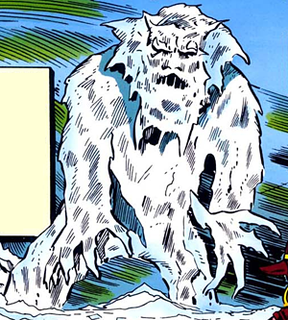
Ymir is a fictional character appearing in American comic books published by Marvel Comics. He is based on the frost giant of the same name from Norse mythology.

Frigga is a fictional character appearing in American comic books published by Marvel Comics. The character appears in particular in those featuring the superhero Thor, who is Frigga's son. Based on both Frigg and Freyja of Norse mythology, she was created by writers Stan Lee and Robert Bernstein and artist Joe Sinnott, and first appeared in Journey into Mystery #92.
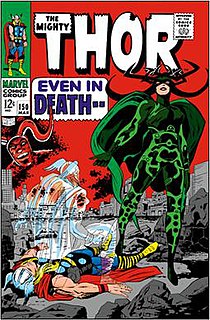
Hela is a fictional character appearing in American comic books published by Marvel Comics. The Asgardian goddess of death is based on the Norse goddess Hel. The ruler of Hel and Niflheim, the character has been a frequent foe of Thor. Debuting in the Silver Age of comic books, Hela first appeared in Journey into Mystery #102 and was adapted from Norse mythology by editor/writer Stan Lee and artist/writer Jack Kirby.

Tyr is a fictional character, an Asgardian god appearing in American comic books published by Marvel Comics. The character is based on the Norse god of the same name. Along with Thor and Balder, he is one of Odin's biological sons.

Thor Odinson is a fictional superhero appearing in American comic books published by Marvel Comics. The character, which is based on the Norse deity of the same name, is the Asgardian god of thunder who possesses the enchanted hammer, Mjolnir, which grants him the ability to fly and manipulate weather amongst his other superhuman attributes.

Laufey is a fictional supervillain appearing in American comic books published by Marvel Comics. The character is depicted usually as an enemy of the Asgardian king Odin, father of Thor. He is the King of the Frost Giants, the biological father of Thor's adopted brother and archenemy, Loki. Created by writer Stan Lee and artist Jack Kirby, he first appeared in Journey into Mystery #112, and was based on the frost giantess of the same name who in Norse mythology was actually the mother of Loki.

Hugin and Munin are fictional characters appearing in American comic books published by Marvel Comics. They are based on the ravens of the same names from Norse mythology.

















